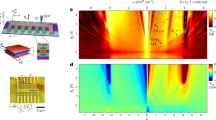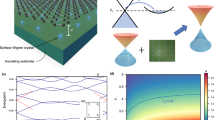Abstract
The response of Dirac fermions to a Coulomb potential is predicted to differ significantly from how non-relativistic electrons behave in traditional atomic and impurity systems1,2,3. Surprisingly, many key theoretical predictions for this ultra-relativistic regime have not been tested4,5,6,7,8,9,10,11,12. Graphene, a two-dimensional material in which electrons behave like massless Dirac fermions13,14, provides a unique opportunity to test such predictions. Graphene’s response to a Coulomb potential also offers insight into important material characteristics, including graphene’s intrinsic dielectric constant6,8, which is the primary factor determining the strength of electron–electron interactions in graphene15. Here we present a direct measurement of the nanoscale response of Dirac fermions to a single Coulomb potential placed on a gated graphene device. Scanning tunnelling microscopy was used to fabricate tunable charge impurities on graphene, and to image electronic screening around them for a Q = +1|e| charge state. Electron-like and hole-like Dirac fermions were observed to respond differently to a Coulomb potential. Comparing the observed electron–hole asymmetry to theoretical simulations has allowed us to test predictions for how Dirac fermions behave near a Coulomb potential, as well as extract graphene’s intrinsic dielectric constant: ɛg = 3.0±1.0. This small value of ɛg indicates that electron–electron interactions can contribute significantly to graphene properties.
This is a preview of subscription content, access via your institution
Access options
Subscribe to this journal
Receive 12 print issues and online access
$259.00 per year
only $21.58 per issue
Buy this article
- Purchase on SpringerLink
- Instant access to full article PDF
Prices may be subject to local taxes which are calculated during checkout




Similar content being viewed by others
References
Greiner, W., Muller, B. & Rafelski, J. Quantum Electrodynamics of Strong Fields (Springer, 1985).
Landau, L. D. & Lifshitz, E. M. Quantum Mechanics: Non-relativistic Theory (Pergamon, 1981).
Zeldovic, Y. B. & Popov, V. S. Electronic structure of superheavy atoms. Sov. Phys. Usp 14, 673–694 (1972).
Biswas, R. R., Sachdev, S. & Son, D. T. Coulomb impurity in graphene. Phys. Rev. B 76, 205122 (2007).
Novikov, D. S. Elastic scattering theory and transport in graphene. Phys. Rev. B 76, 245435 (2007).
Pereira, V. M., Nilsson, J. & Castro Neto, A. H. Coulomb impurity problem in graphene. Phys. Rev. Lett. 99, 166802 (2007).
Shytov, A. V., Katsnelson, M. I. & Levitov, L. S. Atomic collapse and quasi-Rydberg states in graphene. Phys. Rev. Lett. 99, 246802 (2007).
Shytov, A. V., Katsnelson, M. I. & Levitov, L. S. Vacuum polarization and screening of supercritical impurities in graphene. Phys. Rev. Lett. 99, 236801 (2007).
Terekhov, I. S., Milstein, A. I., Kotov, V. N. & Sushkov, O. P. Screening of Coulomb impurities in graphene. Phys. Rev. Lett. 100, 076803 (2008).
Chen, J. H. et al. Charged-impurity scattering in graphene. Nature Phys. 4, 377–381 (2008).
McChesney, J. L. et al. Extended van Hove singularity and superconducting instability in doped graphene. Phys. Rev. Lett. 104, 136803 (2010).
Zhou, S. Y., Siegel, D. A., Fedorov, A. V. & Lanzara, A. Metal to insulator transition in epitaxial graphene induced by molecular doping. Phys. Rev. Lett. 101, 086402 (2008).
Novoselov, K. S. et al. Two-dimensional gas of massless Dirac fermions in graphene. Nature 438, 197–200 (2005).
Zhang, Y., Tan, Y. W., Stormer, H. L. & Kim, P. Experimental observation of the quantum Hall effect and Berry’s phase in graphene. Nature 438, 201–204 (2005).
Kotov, V. N., Uchoa, B., Pereira, V. M., Castro Neto, A. H. & Guinea, F. Electron–electron interactions in graphene: Current status and perspectives. Rev. Mod. Phys. http://arxiv.org/abs/1012.3484 (2011, in the press).
Li, X. et al. Large-area synthesis of high-quality and uniform graphene films on copper foils. Science 324, 1312–1314 (2009).
Dean, C. R. et al. Boron nitride substrates for high-quality graphene electronics. Nature Nanotech. 5, 722–726 (2010).
Decker, R. et al. Local electronic properties of graphene on a BN substrate via scanning tunneling microscopy. Nano Lett. 11, 2291–2295 (2011).
Xue, J. et al. Scanning tunnelling microscopy and spectroscopy of ultra-flat graphene on hexagonal boron nitride. Nature Mater. 10, 282–285 (2011).
Brar, V. W. et al. Gate-controlled ionization and screening of cobalt adatoms on a graphene surface. Nature Phys. 7, 43–47 (2011).
Marczinowski, F., Wiebe, J., Meier, F., Hashimoto, K. & Wiesendanger, R. Effect of charge manipulation on scanning tunneling spectra of single Mn acceptors in InAs. Phys. Rev. B 77, 115318 (2008).
Pradhan, N. A., Liu, N., Silien, C. & Ho, W. Atomic scale conductance induced by single impurity charging. Phys. Rev. Lett. 94, 076801 (2005).
Li, J., Schneider, W-D. & Berndt, R. Local density of states from spectroscopic scanning-tunneling-microscope images: Ag(111). Phys. Rev. B 56, 7656–7659 (1997).
Wittneven, C., Dombrowski, R., Morgenstern, M. & Wiesendanger, R. Scattering states of ionized dopants probed by low temperature scanning tunneling spectroscopy. Phys. Rev. Lett. 81, 5616–5619 (1998).
Zhang, Y. et al. Giant phonon-induced conductance in scanning tunnelling spectroscopy of gate-tunable graphene. Nature Phys. 4, 627–630 (2008).
Ando, T. Screening effect and impurity scattering in monolayer graphene. Phys. Soc. Jpn 75, 074716 (2006).
Hwang, E. H. & Das Sarma, S. Dielectric function, screening, and plasmons in two-dimensional graphene. Phys. Rev. B 75, 205418 (2007).
Brar, V. W. et al. Observation of carrier-density-dependent many-body effects in graphene via tunneling spectroscopy. Phys. Rev. Lett. 104, 036805 (2010).
Reed, J. P. et al. The effective fine-structure constant of freestanding graphene measured in graphite. Science 330, 805–808 (2010).
Elias, D. C. et al. Dirac cones reshaped by interaction effects in suspended graphene. Nature Phys. 7, 701–704 (2011).
Siegel, D. A. et al. Many-body interactions in quasi-freestanding graphene. Proc. Natl Acad. Sci. USA 108, 11365–11369 (2011).
Rutter, G. M. et al. Scattering and interference in epitaxial graphene. Science 317, 219–222 (2007).
Manoharan, H. C., Lutz, C. P. & Eigler, D. M. Quantum mirages formed by coherent projection of electronic structure. Nature 403, 512–515 (2000).
Acknowledgements
Research supported by the Office of Naval Research Multidisciplinary University Research Initiative award no. N00014-09-1-1066 (graphene device preparation and characterization), by the Director, Office of Science, Office of Basic Energy Sciences of the US Department of Energy under contract no. DE-AC02-05CH11231 (STM instrumentation development and measurements), and by the National Science Foundation award no. DMR-0906539 (numerical simulations).
Author information
Authors and Affiliations
Contributions
Y.W., V.W.B. and M.F.C. designed the experiment and made the measurements. Q.W., W.R., H-Z.T. and A.Z. facilitated the sample fabrication. A.V.S., L.S.L. and Y.W. carried out the theoretical calculation. Y.W., V.W.B., A.V.S., L.S.L. and M.F.C. carried out the analysis and wrote the paper.
Corresponding author
Ethics declarations
Competing interests
The authors declare no competing financial interests.
Supplementary information
Supplementary Information
Supplementary Information (PDF 1108 kb)
Rights and permissions
About this article
Cite this article
Wang, Y., Brar, V., Shytov, A. et al. Mapping Dirac quasiparticles near a single Coulomb impurity on graphene. Nature Phys 8, 653–657 (2012). https://doi.org/10.1038/nphys2379
Received:
Accepted:
Published:
Issue date:
DOI: https://doi.org/10.1038/nphys2379
This article is cited by
-
Temperature Dependence of the Ground State of Impurity Bound Magneto-Acoustic Polarons in Monolayer Graphene
Journal of Low Temperature Physics (2021)
-
A molecular shift register made using tunable charge patterns in one-dimensional molecular arrays on graphene
Nature Electronics (2020)
-
Quantum-dot assisted spectroscopy of degeneracy-lifted Landau levels in graphene
Nature Communications (2020)
-
Geometric and Electronic Behavior of C60 on PTCDA Hydrogen Bonded Network
Chemical Research in Chinese Universities (2020)
-
Selective control of molecule charge state on graphene using tip-induced electric field and nitrogen doping
npj 2D Materials and Applications (2019)



